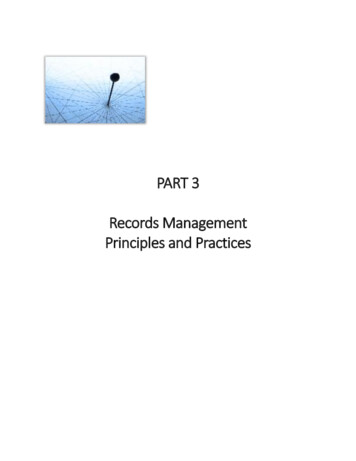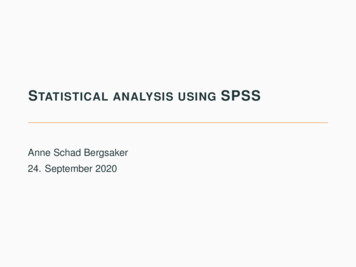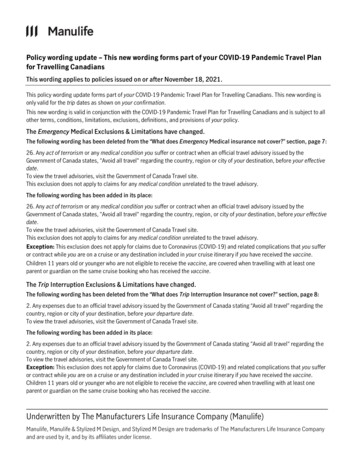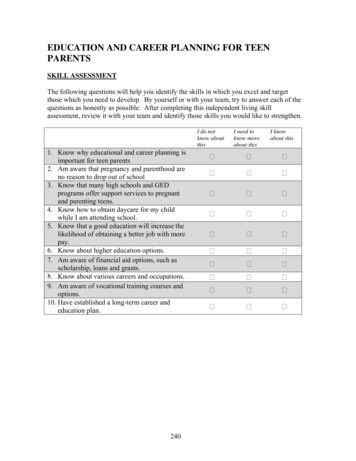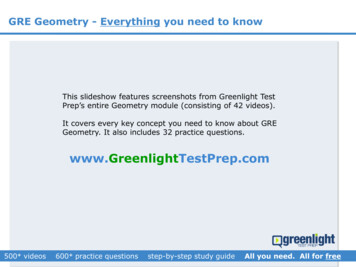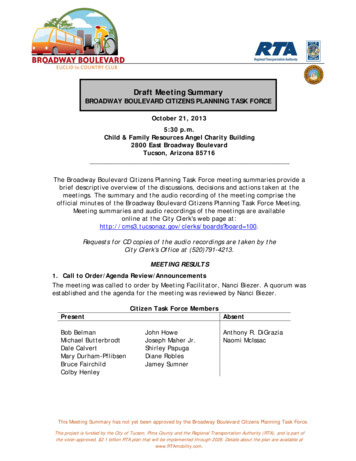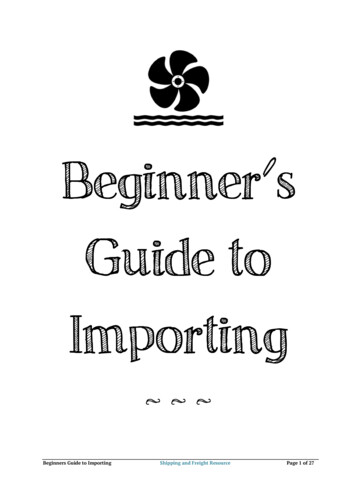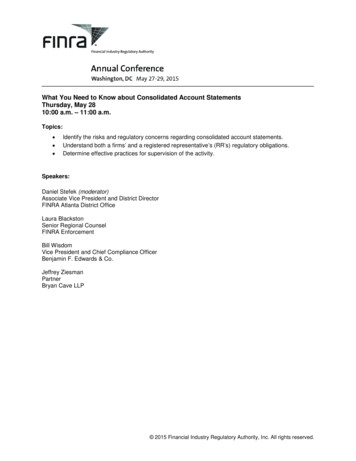
Transcription
What You Need to Know about Consolidated Account StatementsThursday, May 2810:00 a.m. – 11:00 a.m.Topics: Identify the risks and regulatory concerns regarding consolidated account statements.Understand both a firms’ and a registered representative’s (RR’s) regulatory obligations.Determine effective practices for supervision of the activity.Speakers:Daniel Stefek (moderator)Associate Vice President and District DirectorFINRA Atlanta District OfficeLaura BlackstonSenior Regional CounselFINRA EnforcementBill WisdomVice President and Chief Compliance OfficerBenjamin F. Edwards & Co.Jeffrey ZiesmanPartnerBryan Cave LLP 2015 Financial Industry Regulatory Authority, Inc. All rights reserved.
What You Need to Know AboutConsolidated Account StatementsFINRA Annual ConferenceMay 28, 2015 Washington, DC
PanelistsModerator: Daniel Stefek, Associate Vice President and District Director,FINRA Atlanta District OfficePanelists: Laura Leigh Blackston, Senior Regional Counsel, FINRA Bill Wisdom, Vice President and Chief Compliance Officer ofBenjamin F. Edwards & Company, Inc. Jeffrey Ziesman, Partner of Bryan Cave, LLP2015 FINRA Annual Conference 2015 FINRA. All rights reserved.1
What is a Consolidated Report? A single document that combines information regardingmost or all of the customer’s financial holdings, regardlessof where those assets are held. May be referred to by many names, including ConsolidatedStatement, Performance Reports, etc. These reports do not replace the account statementsgoverned by NASD Rule 2340 (Investment Companies). Reports can be provided to customers by mail, duringoffice visits, or electronically. Many of the systems allow for customization by theregistered rep (RR), including entry of values for assetsheld away from the firm.2015 FINRA Annual Conference 2015 FINRA. All rights reserved.2
Consolidated Statements: Risks Associated withConsolidated Reports Account information can be used to disguise a theft orother scheme. Customers misled or confused regarding accountvalue and/or performance history Banks, mortgage companies, other 3rd parties may bemisled regarding value of customer’s assets. Firms have liability for what a registeredrepresentative represents to a customer. TheConsolidated Statement may not match official firmaccount statement.2015 FINRA Annual Conference 2015 FINRA. All rights reserved.3
Consolidated Statements: Firm and RR ComplianceResponsibilities Statements must be clear, accurate and not misleading. For assets held at the Firm, valuations must be consistentwith valuations on the Firm’s official account statements. For external accounts or assets, reasonable steps areneeded to accurately reproduce information obtained. Clearly differentiate between assets held at the firm andthose held away. Must not be represented as a substitute for, and must bedistinguished from, account statements that are requiredby Rule. If the Firm cannot validate data for external assets, the firmmust clearly and prominently disclose that valuation data isunverified.2015 FINRA Annual Conference 2015 FINRA. All rights reserved.4
Consolidated Statements: Common Exam Findings Lack of or inadequate written supervisory procedures Lack of or poor disclosures Inaccurate valuation of illiquid investments (e.g., privateplacements and real estate investment trusts (REITs) Failure of the Firm to retain the reports provided tocustomers Lack of Firm knowledge of which RR’s are providing reportsand extent to which manual entries are provided Lack of testing of manual entries Reliance of RR’s to provide reports to Firm for supervision Delegation to branch managers to supervise, but lack ofbranch inspection to verify supervision Reg SP violations2015 FINRA Annual Conference 2015 FINRA. All rights reserved.5
Consolidated Statements: Sample InadequateDisclosure This report may contain Manually Entered Assets. Theaccuracy and authenticity of Manually Entered Assets isreliant solely on the provider of the information and notcontrolled by or attested to as accurate by [the Firm], itsaffiliates or Business Partners. Any informationrepresented as Manually Entered Assets should beregarded as information only and not interpreted as officialor legal financial positions. Disclosure implies that valuation was obtained from issueror some other official source. Where it may only have beenobtained from the original / par price and inserted by theRR. Disclosure does not obviate the duty to take reasonablesteps to reflect accurate valuation.2015 FINRA Annual Conference 2015 FINRA. All rights reserved.6
Consolidated Statements: Possible RuleConsiderations and Violations FINRA Rule 2210 – Consolidated reports may beconsidered sales literature or correspondencedepending on method of dissemination. As such theymust be clear, accurate and not misleading. FINRA Rule 3010 (a),(b), and (d) – Where the Firm doesnot have an adequate system for supervising the useof the consolidated reports. SEC Rule 17a-4 – Preservation of books and records(communications sent by the broker-dealer) where theFirm has not retained copies of the statements. FINRA Rules 2010, 2020, or SEC Rule 10b-5 – If a firmor RR provides false valuations to conceal losses orother fraudulent activity.2015 FINRA Annual Conference 2015 FINRA. All rights reserved.7
Consolidated Statements: Firm Supervisory andRecordkeeping Responsibilities Under Notice 10-19 Review templates before use Know whether a RR is using consolidated reports Review manual entries for valuation accuracy Retain copies of statements for three years Make reasonable efforts to obtain accurate valuation Ensure proper disclosures where values cannot be verifiedfor a particular asset Ensure that values on official customer statements andconsolidated reports are consistent The Notice also stresses that if a firm is unable toadequately supervise the use of the reports, it mustprohibit their dissemination and take steps to ensure thatregistered representatives comply with the prohibition.2015 FINRA Annual Conference 2015 FINRA. All rights reserved.8
Consolidated Statements: Effective Practices Fully understand the extent of use by RR Consider use of service providers that can provideexception reports and other tools for supervising Consider disallowing manual entry capabilities Limit the types of consolidated reporting systems that canbe used Publish values for directly held assets and check to makesure RRs are using those values Use systems that have pdf capability Educate employees on the risks, firm requirements andcontrols Branch inspection program includes review of consolidatedreports2015 FINRA Annual Conference 2015 FINRA. All rights reserved.9
Consolidated Statements: Points to Stress DuringFirm Training Fully define what constitutes a consolidated report Clarify what type of reports Firm allows (restricted tocertain vendors, spreadsheet generated by RR, inoffice displays, etc.) Clearly explain how values are to be determined Review all supervisory responsibilities with mangers Explain privacy issues regarding assets held away Train staff on encryption of reports that are sentelectronically2015 FINRA Annual Conference 2015 FINRA. All rights reserved.10
Consolidated Statements: FINRA DisciplinaryActions FINRA Fines Triad Advisors and Securities America aTotal of 1.2 Million for Consolidated ReportingViolations (News Release March 12, 2014) Cases involve multi-year failure to superviseconsolidated reports Both Triad Advisors and Securities America had asystem that permitted their representatives to createconsolidated reports, allowing them to entercustomized asset values for accounts held away fromthe firm and to provide the reports to customers.2015 FINRA Annual Conference 2015 FINRA. All rights reserved.11
Consolidated Statements: FINRA DisciplinaryActions At Triad Advisors, a number of consolidated reportssent to customers reflected fictitious promissorynotes or other fictitious assets, which enabled tworepresentatives to conceal their misconduct. Other consolidated reports contained inflated valuesfor investments, some of which were in default orreceivership. Securities America relied on RR’s to submitconsolidated statements for review; an honor systemthat did not always work.2015 FINRA Annual Conference 2015 FINRA. All rights reserved.12
Consolidated Statements: FINRA DisciplinaryActionsFINRA Sanctions Three Firms for Inadequate Supervision ofConsolidated Reports (News Release March 30, 2015) FINRA sanctioned three firms – H. Beck, Inc., LaSalle St.Securities, LLC, and J.P. Turner & Company, LLC – with fines of 425,000, 175,000 and 100,000, respectively, for inadequatesupervision of consolidated reports provided to customers andother violations. H. Beck and J.P. Turner did not have any written proceduresspecifically addressing the use and supervision of consolidated reports. While LaSalle St. Securities had written procedures related toconsolidated reports, it failed to enforce the procedures and did notprovide proper training to its representatives regarding their Across all three firms, the RR’s utilized reports that allowed them toenter customized values for accounts or investments held away fromthe firm, yet the firms’ procedures did not provide safeguards, such asrequiring supporting data to verify accuracy.2015 FINRA Annual Conference 2015 FINRA. All rights reserved.13
Regulatory Notice10-19Consolidated ReportsApril 2010FINRA Reminds Firms of Responsibilities WhenProviding Customers With Consolidated FinancialAccount ReportsExecutive SummaryThe practice of providing customers with consolidated financial accountreporting has become increasingly common in the financial servicesindustry. In many cases, these reports offer a single document thatcombines information regarding most or all of the customer’s financialholdings, regardless of where those assets are held. Firms are remindedthat these reports represent communications with the public by the firm;the dissemination of these reports must comply with all applicable FINRArules as well as the federal securities laws.Notice Type GuidanceSuggested Routing ComplianceLegalOperationsRegistered RepresentativesSenior ManagementSystemsTrainingKey TopicsAccount StatementsCommunications with the PublicCorrespondenceInternal ControlsSupervisionSupervisory Controls SystemsAs investor demand for this service has grown and as increasinglysophisticated software and data service providers have become available,firms have developed differing practices for generating these communications.If not rigorously supervised, this activity can raise a number of regulatoryconcerns, including the potential for communicating inaccurate, confusingor misleading information to customers, lapses in supervisory controls,and the use of these reports for fraudulent or unethical purposes. This Notice reminds firms of their responsibilities to ensure that theycomply with all applicable rules when engaging in this activity, andhighlights a number of sound practices. Firms are strongly encouraged toreview the overall adequacy and effectiveness of their current policies andprocedures relating to their consolidated reporting. Any firm that cannotproperly supervise the dissemination of consolidated reports by itsregistered representatives must prohibit the dissemination of thosereports and take the necessary steps to ensure that its registeredrepresentatives comply with this prohibition.Referenced Rules & Notices NASD Rule 2210NASD Rule 2340NASD Rule 3010NASD Rule 3012NYSE Rule 342NYSE Rule 409Regulatory Notice 08-27NTM 05-481
10-19April 2010General questions about this Notice should be directed to: Steve Kasprzak, Associate Director & Principal Counsel, Sales Practice Policy,Member Regulation, at (646) 315-8603; or Bill Hayden, Director, Emerging Regulatory Issues, at (202) 728-8860.For questions about communications with the public, contact Amy Sochard, Director,Programs & Investigations, Advertising Regulation, at (240) 386-4508.Discussion and BackgroundMany firms, as a service to their customers, provide documents that consolidateinformation regarding a customer’s various financial holdings.1 For the purpose of thisNotice we will refer to this practice and document as “consolidated reporting” and“consolidated reports,” respectively. These consolidated reports offer a broad view ofcustomers’ investments, may include assets held away from the firm, and may providenot only account balances and valuations, but performance data as well. In many casesthese consolidated reports are prepared at the request of the customer, who mayalso direct which of his or her accounts to include and provide access to data fornon-held accounts. These communications may supplement, but do not replace, thecustomer account statement required pursuant to NASD Rule 2340 and NYSE Rule 409,2which is prepared and disseminated to the customer through a separate process.Consolidated reports may not be represented as a substitute for, and must bedistinguished from, account statements that are required by rule.Firms create consolidated reports through fully integrated, in-house data gathering andreporting systems, fully outsourced solutions from third-party vendors,3 “off-the-shelf”software applications or a combination of these methods. Firms also disseminate theseconsolidated reports through a variety of means, such as direct mailing to customers,providing access to secure servers via the Internet and hand delivery during face-to-facemeetings. The consolidated reports themselves may contain a variety of informationand may be produced as a highly customized document created by an individualrepresentative, or as a standardized report created by a firm system. To the extentindividual representatives create consolidated reports, firms are required to supervisethis activity, and both the firm and the individual representatives are responsible forcompliance with all applicable rules.Consolidated reports are communications with the public. Therefore, they must beclear, accurate and not misleading.4 For assets held at the firm, this includes providinginformation, including valuations, that is consistent with the customer’s officialaccount statement.5 For assets held away, this includes, among other things, takingreasonable steps to accurately reproduce information obtained regarding outsideaccounts and not to include information that is false or misleading.Consolidated reports, particularly those published on firm letterhead, can create a2Regulatory Notice
April 2010misconception that the firm produced or verified all of the data, including the valuationof assets held away. Therefore, these reports should be constructed and provided insuch a manner that neither customers nor third parties with whom the customerinteracts (e.g., banks, mortgage companies, other broker-dealers) are likely to beconfused or misled as to the nature of the information presented, or mistake thesedocuments for official account statements regarding the reported assets. The reportsshould clearly delineate between information regarding assets held on behalf of thecustomer, which are included on the firm’s books and records, and other externalaccounts or assets.If a firm is unable to test or otherwise validate data for non-held assets, includingvaluation information, the firm should clearly and prominently disclose that theinformation provided for those assets is unverified. In addition, to the extent aconsolidated report contains information regarding financial products that are outsidea registered representative’s area of proficiency, representatives must discuss andpresent these financial products in a manner that does not mislead customers as tothe scope of the representative’s financial expertise.6Consolidated reports are also subject to the regulatory requirements regardingsupervision and internal controls, records retention, privacy and safeguarding ofcustomer information.7 Effective firm controls would include procedures to vet andapprove consolidated report templates for compliance with regulatory requirementsbefore they are put into production. These reviews can help ensure that any newconsolidated report-generating process complies with regulatory requirements andfirm policies, and that it is integrated into the firm’s supervisory control program.Similar controls should be put in place for any programming that permits customization,as well as any subsequent changes to the approved templates or programming.The risks associated with a firm’s failure to maintain adequate safeguards over the useand dissemination of customer account information are well established. Beyond theobvious concern regarding the use of account information for fraudulent activity, evenwell-intentioned but incautious consolidated reporting could result in customers beingmisled or confused. Given the reliance that customers may place on consolidatedreports and the potential consequences if these communications contain mistakesor are misused by firm personnel, firms must review their consolidated reportingprograms with particular care. The more complex a firm’s program for consolidatedreporting, the more difficult it may be to conform that reporting to applicable rulerequirements. Factors that contribute to program complexity include: the production within a firm of a large number of varying types of consolidatedreports, especially consolidated reports that are highly customizable; reporting on a wide variety of asset classes, especially assets held outside thefirm; and a decentralized consolidated reporting structure employing multiple reportingsystems.8Regulatory Notice310-19
10-19April 2010If a firm provides this service to customers, it must ensure that the size and complexityof the consolidated reporting program does not exceed the firm’s ability to supervisethe activity and to subject it to a rigorous system of internal controls. Any firm thatcannot properly supervise the dissemination of consolidated reports by its registeredrepresentatives must prohibit the dissemination of those reports and take necessarysteps to ensure that its registered representatives comply with this prohibition.Sound PracticesFINRA encourages firms to consider the practices described below when reviewing theirconsolidated reporting programs. This Notice is not intended to be a comprehensiveroadmap for compliance and supervision; rather, it outlines measures that may assistfirms in complying with their various supervisory obligations. Firms should considerthese practices in assessing their own procedures and in implementing improvementsthat will best protect their customers. Firms must adopt procedures and controls thatare most effective given the firm’s size, structure and operations.1. Ongoing audits and reviewsDue to the potential risks related to consolidated reporting, some firms haveincorporated a review of the consolidated reporting process as a standard elementin their testing and oversight programs. These firms test for regulatory compliance,data accuracy and adherence to supervisory procedures in audits, branch officereviews and as an ongoing part of their program of internal inspections requiredby NASD Rule 3010. Some firms require branch offices that produce consolidatedreports to obtain an annual third-party audit of the process.2. Centralize reporting systemsMaintaining multiple consolidated reporting systems can create a patchwork ofprocesses and applications that may be difficult to adequately supervise. Somefirms have chosen to centralize their consolidated reporting programs by requiringuse of a single firm-wide system. Other firms that allow multiple report-producingsystems, subject them to a centralized review and approval process. Participantsin this review and approval process may include personnel from informationtechnology, compliance and legal departments.4Regulatory Notice
April 20103. Customer addressesSome of the stronger programs require that all consolidated reports be mailedcentrally using the customer’s address of record,9 and have processes in placethat reconcile address information used for account statements and consolidatedreports. In the limited circumstances where different addresses are used to delivercustomer account statements and consolidated reports, firms should maintaindocumentation explaining the discrepancy and indicating that the customer wasprovided notice or acknowledged the differing addresses.104. Assets held awaySome firms verify, when possible, information pertaining to assets held away.Some of these firms have opted not to include assets in the consolidated reportwhen the firm cannot verify their existence or cannot validate the valuations.5. Supporting documentationSome firms maintain supporting documentation for reported assets with thecustomer file, or otherwise have it available to be reviewed alongside theconsolidated report. This documentation may include information regardingsource of data and methods used to determine accuracy and asset valuation.The information may be useful in discussing the consolidated reports withcustomers, in validating the accuracy of consolidated report-generating systemsand for internal control/audit testing purposes.6. Source documentsIt is sound practice to encourage customers to review and maintain the originalsource documents that are integrated into the consolidated report, such as thestatements for individual accounts held away from the broker-dealer. Customersmay be tempted to disregard these source documents because of the convenienceof the consolidated report. However, source documents may contain notices,disclosures and other information important to the customer, and may also serveas a reference should questions arise regarding the accuracy of the information inthe consolidated report.Regulatory Notice510-19
10-19April 20107. Report designThe design and formatting of consolidated reports is important for ensuringinformation is clearly communicated. In addition to the requirements outlinedabove, firms are encouraged to include, when applicable, the followingdisclosures:11 that the consolidated report is provided for informational purposes and asa courtesy to the customer, and may include assets that the firm does nothold on behalf of the customer and which are not included on the firm’sbooks and records; the names of the entities providing the source data or holding the assets, theirrelationship with each other (e.g., parent, subsidiary or affiliated organization)and their respective functions (introducing/carrying brokerage firms, funddistributor, banking/insurance product providers, etc.); a statement clearly distinguishing between assets held or categories of assetsheld by each entity included in the consolidated report; the customer’s account number and contact information for customer serviceat each entity included in the consolidated report; identify that assets held away may not be covered by SIPC12; and if the consolidated report provides aggregate values for several different assets,an explanation of how the aggregated values of the different types of assetswere arithmetically derived from separate asset totals.8. Disclosures and attestationsTo help ensure that a customer is apprised of the nature of the consolidatedreporting process, and to ensure delivery of any disclosures or other pertinentinformation, firms may consider obtaining the customer’s signed acknowledgementthat he or she has been provided with the relevant disclosures and understandsthe nature and limitations of the consolidated reporting process. These disclosuresmay, for example, be included with applicable communications regarding privacyprotections. Firms should consider a means to refresh this notice on a periodic basis.6Regulatory Notice
April 2010Endnotes1This reporting is most commonly issued byfirms that maintain an affiliated investmentadviser or by registered representatives whoalso provide investment advisory services totheir customers.2The FINRA rulebook currently consists of:(1) FINRA Rules; (2) NASD Rules; and (3) rulesincorporated from NYSE (Incorporated NYSERules) (together, the NASD Rules and theIncorporated NYSE Rules are referred to asthe Transitional Rulebook). While the NASDRules generally apply to all FINRA memberfirms, the Incorporated NYSE Rules applyonly to those members of FINRA that arealso members of the NYSE (Dual Members).The FINRA Rules apply to all FINRA memberfirms, unless such rules have a morelimited application by their terms. For moreinformation about the rulebook consolidationprocess, see Information Notice 3/12/08(Rulebook Consolidation Process). Forconvenience, the Incorporated NYSE Rulesare referred to as the NYSE Rules.3Vendors include Web-based application serviceproviders (ASPs) that aggregate financial dataand create reports to firm specifications thatmay be mailed to customers or, if the firmdesires, can be accessed on a read-only basisfrom the ASP’s Web server. To the extent thatfirms rely on third-party vendors, firms areresponsible for complying with applicablerequirements regarding outsourcing, asdiscussed in Notice to Members 05-48. TheNotice clarifies firm responsibilities whenoutsourcing "covered activities," which theNotice identifies as activities or functions that,if performed directly by firms, would berequired to be the subject of a supervisorysystem and written supervisory procedurespursuant to NASD Rule 3010.4Depending on the form, content and methodof dissemination, these consolidated reportsmay be considered sales literature orcorrespondence. As such, they may be subjectto various requirements outlined in NASDRules 2210 and 2211 and associated guidance,such as the requirement for clear andprominent display of the firm’s name oncommunications and disclosures relatedto use of performance information.5Inaccuracies may include discrepanciesassociated with having consolidated reportsand customer account statements producedthrough separate systems or by differententities. For example, firms have reportedfinding numerous instances in which the samein-house transaction was reflected differently ineach document, thereby requiring a correctionbefore publication or dissemination.6NASD Rule 2210(d)(1)(A). See also RegulatoryNotice 08-27 (May 2008) (MisleadingCommunications About Expertise).7The better information security programsroutinely test controls over access to systemsand data related to the reporting process aspart of the firm’s internal controls regime.Access controls must be rigorously supervisedto avoid unauthorized use or manipulation ofcustomer account data.8These multi-system situations often arisewhen a firm affiliates with or acquires a newgroup of representatives or branch officesthat bring with them legacy systems. In someinstances, a reporting system may be uniqueto a single branch office, even to the extentthat a single branch may maintain a separatecontractual relationship with a third-partyvendor to provide these services. 2010 FINRA. All rights reserved. FINRA and other trademarks of the Financial Industry Regulatory Authority,Inc. may not be used without permission. Regulatory Notices attempt to present information to readers in aformat that is easily understandable. However, please be aware that, in case of any misunderstanding, therule language prevails.Regulatory Notice710-19
10-19April 2010Endnotes continued9Firms are required to have procedures toreview, monitor and validate customerchanges of address. These policies andprocedures must include “a means or methodof customer confirmation, notification, orfollow-up that can be documented.” NASDRule 3012(a)(2)(B) and NYSE Rule 401.10This is consistent with NYSE Rule 409(b) andFINRA’s proposed rule change to adopt NASDRule 2340 (Customer Account Statements)as FINRA Rule 2231. Proposed SupplementaryMaterial .01 (Transmission of CustomerAccount Statements to Other Persons orEntities) would expressly require a firm toobtain written instructions from the customerin order to send/deliver customer statements,confirmations or other communications toother persons or entities. See SecuritiesExchange Act Release No. 59921 (May 14,2009), 74 FR 23912 (May 21, 2009).811These elements are drawn from existingguidance relating to multi-account reportingpractices for customer account statements inNYSE Rule Interpretations 409(a)/04 (AssetsExternally Held and Included on StatementsSolely as a Service to Customers) and (a)/06(Use of Summary Statements) and areconsistent with FINRA’s proposed rule changeto adopt NASD Rule 2340 (Customer AccountStatements) as FINRA Rule 2231. The multiaccount reporting guidance in proposed FINRARule 2231, Proposed Supplementary Material.04 (Assets Externally Held and Included onStatements Solely as a Service to Customers)and Proposed Supplementary Material .06(Use of Summary Statements) aresubstantially unchanged from existing NYSERule Interpretations 409(a)/4 and 409(a)/6.See Securities Exchange Act Release No. 59921(May 14, 2009), 74 FR 23912 (May 21, 2009).12Firms should consider including a disclosureclarifying that their firm’s SIPC coverage wouldonly apply to those assets held at the firm,and to the extent some of the other reportedentities may be SIPC members, customersshould contact their financial representativeor the other entity or refer to the other entity’sstatement regarding SIPC membership.Regulatory Notice
Consolidated reports may not be represented as a substitute for, and must be distinguished from, account statements that are required by rule. Firms create consolidated reports through fully integrated, in-house data gathering and reporting systems, fully outsourced solutions from third-party vendors, 3

